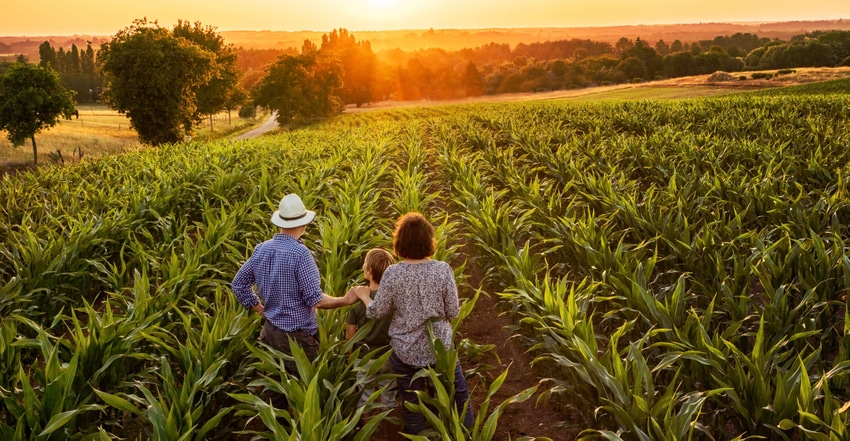Farmers can obtain a Regenerative Organic Certification, focusing on animal welfare, fairness to workers, soil health and land management, offered by the Regenerative Organic Alliance.

When left to its own devices, nature has a way of harmoniously using a variety of plants, animals and microbes, operating together to consistently restore health to land. Yet, modern-day farming practices have disrupted this natural regenerative process contributing to various global issues such as climate change, depletion of organic matter in soil and degraded soil biodiversity, and negatively affecting the water cycle. This has left concerned consumers to question current farming practices and equally concerned farmers to answer with a new type of farming—regenerative agriculture.
Put into simple terms, regenerative agriculture can be thought of as a type of biomimicry that emulates nature. Farmers who treat their farms as an all-inclusive ecosystem with animals, plants and soil co-evolving are practicing regenerative agriculture. A more robust understanding, however, is found in history.
It started in 1942 when J.I. Rodale, founder of Rodale Institute, a nonprofit organization focused on organic agriculture, advocating policies that support farmers and educating people about organic, scratched the words “Healthy Soil=Healthy Food=Healthy People” onto a . The more Rodale learned about organic food growing, the more he realized that to preserve and improve human health, restoration and protection of natural soil health is a must.
During World War II, there was a sudden shortage of nitrogen fertilizer; it was being used to make munitions. This exposed the nutrient poverty of the nation’s soil. Before the War, practices such as the use of manure as fertilizer and the growing of cover crops to protect and enrich the soil were standard farming practices. It wasn’t until after the War that chemical fertilizers, pesticides, herbicides, soil tilling and preservatives and additives for taste and appearance became popular, rapidly changing agriculture. Fast forward to present-day farming, and the effects of these man-made farming interventions are still being felt.
To summarize the major damage since the early 1940s, modern-day farming practices, such as tilling, releases carbon from the soil into the atmosphere and biosphere, which further destabilizes the climate as heat-trapping gases are causing the earth to overheat. Additionally, when soil lacks carbon, it’s unhealthy as microorganisms who feed on it are malnourished.
Regenerative agricultural practices put carbon back into the soil. Take cover cropping as an example, which simply means keeping soil covered with plants. Plants capture carbon dioxide from the air in their leaves, pumping it down through their roots to feed hungry worms, bacteria, amoebas and other microorganisms living in the soil. As the soil becomes carbon-rich, it acts like a giant sponge, soaking up and storing water to provide to plants in times of drought. Other regenerative ways to add carbon back to the soil include increasing crop diversity, composting, not using toxic chemicals, low to no till and getting farm animals back onto the land to manage it naturally, along with carefully planned grazing.
As a hot topic at Natural Products Expo West this year in Anaheim, Calif., talk of regenerative agriculture made its way throughout the conference. The Regenerative Organic Alliance, a coalition of organizations and businesses led by the Rodale Institute, Dr. Bronner’s and Patagonia, launched its Regenerative Organic Certification (ROC), “a holistic agriculture certification encompassing pasture-based animal welfare, fairness to farmers and workers, and robust requirements for soil health and land management,” as stated on its website. Soon after, the alliance rolled out the “ROC Pilot Program” with a mix of farmers and brands participating in the certification framework to determine how written guidelines can be applied with certifying bodies and producers going forward. Applications were accepted until mid-April for the pilot program.
To get a head start on potential ROC certification, farmers can work toward USDA organic certification by participating in a certified transitional organic program. These programs typically assist farmers during the organic transition, which can take three years, by helping them earn more money for their products.
Ardent Mills, an American flour supplier, for example, offers a transitional program for wheat producers.
“During the transitional period, most farmers are having to sell their transitional crops into the conventional market,” explained Shrene White, general manager, the annex by Ardent Mills. “Farmers that fit into our program are being paid a premium for their transitional wheat versus selling into the conventional market.”
Quality Assurance International (QAI), part of the NSF International family of companies, an advocate for certified organic production and a USDA-accredited certifying agency, offers transitional certification to assist farmers on the road to organic. As found on QAI’s website, organizations that grow, produce, manufacture, process and trade in food and beverage, dietary supplements, cosmetics, household cleaners and textile products are eligible. The program consists of unannounced audits and sampling, and increasingly difficult requirements from the first year to the third of the program, all with the intention for transitional farms to become USDA Organic Certified and graduate from the transitional program.
Consumers are becoming more interested and concerned as to where their food products are sourced. This is especially true when it comes to agriculturally produced products such as eggs, meats, dairy products and the like that are staples in many kitchens. People seek label claims, such as locally grown, sustainably sourced, non-GMO (genetically modified organism), organic, no antibiotics, etc., in choosing their food products. As the food transparency trend continues to grow, farmers are tasked with balancing entrepreneurship and moving to a farming model that pleases consumers.
For more information on regenerative agriculture, take a listen to our Healthy INSIDER Podcast: Regenerative Agriculture and Biodynamic Farming.
About the Author(s)
You May Also Like






.png?width=800&auto=webp&quality=80&disable=upscale)